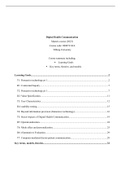Digital Health Communication
Masters course (2023)
Course code: 800872-M-6
Tilburg University
Course summary including;
Learning Goals
Key terms, theories, and models.
Learning Goals...............................................................................................................................2
T1: Persuasive technology pt 1....................................................................................................2
D1: Contextual Inquiry................................................................................................................7
T2: Persuasive technology pt 1....................................................................................................7
D2: Value Specification..............................................................................................................11
T3: User Characteristics.............................................................................................................12
D4: usability testing...................................................................................................................15
T4: Beyond information provision (Immersive technology).....................................................16
T5: Social Aspects of Digital Health Communication...............................................................19
D5: Operationalization...............................................................................................................24
T6: Mode effect and personalization.........................................................................................25
D6: (Summative) Evaluation.....................................................................................................29
T7: Computer-mediated doctor-patient communication............................................................29
Key terms, models, theories........................................................................................................32
, Learning Goals
T1: Persuasive technology pt 1
eHealth / mHealth: use of information communication technology to (support) deliver health
services
Persuasive technology for:
1) Information provision
2) Attitude/behavior change
3) Support the initiation and maintenance of health behaviors requires self-control
Lecture learning goal 1: Understand the main factors increasing and decreasing the impact of
digital health applications
Wide variation in apps popularity in the app store, number of new app releases, and statistics
on usage all suggest huge potential. High expectations of technology + confidence in potential
impact.
However, studies contain a low quality of evidence (in studies themselves and in interventions) +
reveal that there is only a short/brief impact of the intervention.
Systematic Review & Meta-Analysis to examine the actual impact of PA apps (Romeo et al.,
2019): of 178 studies found, most studies were non-robust with non-reliable findings.
Only 7 were included, of which 4 apps used behavior-change theories such as the
TPB. Features: 1) display steps, 2) PA summary, 3) goal setting & achievement, 4)
motivating prompts.
o No significant effect was found, but significance was found when intervention
was <3 months short seem more effective due to motivation dropping which
could impact adherence.
o Isolated interventions seem more effective: e.g., only targeting physical activity!
,Meta-Analysis to examine the effectiveness of changing nutrition behavior & related outcomes
eating behavior (Villinger et al., 2019): again only 41 qualitative sufficient studies were
found.
Most 4 BCT (behavior change techniques) implemented: 1) goals & planning, 2)
feedback & monitoring, 3) social support, 4) shaping knowledge.
Small significant effect found, again for <3 months or 3-6 months interventions.
Evidence-based (effective ingredient) + sufficiency (effective dose)
Health behavior theories - technology acceptance
Behavioral change techniques - engagement
How: holistic approach when developing interventions with CeHReS roadmap (= guidelines for
ehealth development)!
5 phases connected with continuous (formative) evaluating (Flexible, Iterative).
Multidisciplinary.
Holistic = interrelationship to achieve a fit between people, context, and technology. Everything
is connected & evidence-based!!
Persuasive design, participatory development, HCD, business modeling use what is
relevant!
Lecture learning goal 2: Understand and explain the importance of theory use in the development
of digital health apps.
Unpacking the black box: how do we find out what features are effective, is it one feature, is it a
combination?
This could be examined by the extent that theory is used in an intervention.
A systematic review of the importance of the extent of theory use in weight management apps
(Willmot et al., 2019). Distinguish theory use in scientific research in 4 levels in descending
order of level of use:
1) Mentioning/referencing a theory most present 18/24
, 2) Applying the theory in the development of the intervention: predictors used for
intervention techniques, using this to tailor the intervention to users. 17 out of 24
studies
3) Measuring and testing the theory; theory-relevant constructs used pre- and post, reports
of reliability and validity of these constructs 6 out of 24 studies
4) Building and refining the theory: discussing findings, connecting to theory used, mention
mediations, (suggestions of) refinement of theory. 5 out of 24 studies
Significant positive effects seem positively related to extent of theory use (at least level 2/3 or
level 4)
Results indicate that weight-related outcomes may be enhanced when at least one or more
theoretical constructs are explicitly linked to an intervention technique and when theoretical
constructs are included in evaluations.
A theory-based online health behavior intervention for new university students: study Protocol
(Epton et al., 2013)
U@Uni example: multi-device digital health intervention that included a high level of theory
use. BCT constructs were used.
Health behavior change interventions based on theory seem more efficacious.
therefore, the proposal of three behavior changes techniques in U@Uni intervention:
1) Self-affirmation: persuasive as self-affirm enhances self-integrity reflecting upon
values. Reduces defensive processing of health message (= level 2 of theory use,
applying theory)
2) Theory-based messages: usage of TPB to develop messages to address attitude,
subjective norm, and perceived behavioral control.
(Modifiable determinants, in contrast to non-modifiable determinants such as
demographics)
Targeting key beliefs underlying the health behavior
3) Implementation intentions to decrease the intention-behavior gap with an if-then plan.
Translation of good intentions into healthy behavior





